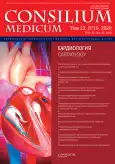Clinical case of successful use of non-invasive ventilation in a patient with a new coronavirus infection
- Authors: Litvin A.Y.1,2, Elfimova E.M.1, Mikhailova O.O.1, Alekseeva T.A.1, Sivakova O.A.1, Danilov N.M.1, Pevzner D.V.1, Dulaev L.O.1, Zyuryaev I.T.1, Gaman S.A.1
-
Affiliations:
- National Medical Research Center for Cardiology
- Pirogov Russian National Research Medical University
- Issue: Vol 22, No 10 (2020)
- Pages: 23-28
- Section: Articles
- URL: https://journals.rcsi.science/2075-1753/article/view/95298
- DOI: https://doi.org/10.26442/20751753.2020.10.200291
- ID: 95298
Cite item
Full Text
Abstract
Full Text
##article.viewOnOriginalSite##About the authors
Aleksandr Yu. Litvin
National Medical Research Center for Cardiology; Pirogov Russian National Research Medical University
Email: alelitvin@yandex.ru
д-р мед. наук, рук. лаб. апноэ сна, гл. науч. сотр. отд. гипертонии Moscow, Russia
Evgeniia M. Elfimova
National Medical Research Center for Cardiologyканд. мед. наук, науч. сотр. лаб. апноэ сна отд. гипертонии Moscow, Russia
Oksana O. Mikhailova
National Medical Research Center for Cardiologyканд. мед. наук, мл. науч. сотр. лаб. апноэ сна отд. гипертонии Moscow, Russia
Tatiana A. Alekseeva
National Medical Research Center for Cardiologyканд. мед. наук, врач-кардиолог 5-го кардиологического отделения гипертонии Moscow, Russia
Olga A. Sivakova
National Medical Research Center for Cardiologyканд. мед. наук, зав. 5-м кардиологическим отд-нием Moscow, Russia
Nikolai M. Danilov
National Medical Research Center for Cardiologyд-р мед. наук, вед. науч. сотр. отд. гипертонии Moscow, Russia
Dmitrii V. Pevzner
National Medical Research Center for Cardiologyканд. мед. наук, зав. блоком интенсивной терапии отд. неотложной кардиологии Moscow, Russia
Lavrentii O. Dulaev
National Medical Research Center for Cardiologyврач-кардиолог блока интенсивной терапии отд. неотложной кардиологии Moscow, Russia
Ilia T. Zyuryaev
National Medical Research Center for Cardiologyврач анестезиолог-реаниматолог блока интенсивной терапии отд. неотложной кардиологии Moscow, Russia
Svetlana A. Gaman
National Medical Research Center for Cardiologyканд. мед. наук, науч. сотр. лаб. РКТ отд. томографии Moscow, Russia
References
- Guan W, Ni Z, Hu Y et al. Clinical Characteristics of Coronavirus Disease 2019 in China. N Engl J Med 2020; 382: 1708-20. doi: 10.1056/NEJMoa2002032
- Wang D, Hu B, Hu C et al. Clinical characteristics of 138 hospitalized patients with 2019 novel coronavirus-infected pneumonia in Wuhan, China. JAMA 2020. doi: 10.1001/jama.2020.1585
- Hernandez AV, Roman YM, Pasupuleti V et al. Hydroxychloroquine or Chloroquine for Treatment or Prophylaxis of COVID-19: A Living Systematic Review. Ann Intern Med 2020; 10.7326/M20-2496. doi: 10.7326/M20-2496
- Cao B, Wang Y, Wen D et al. A Trial of Lopinavir-Ritonavir in Adults Hospitalized with Severe Covid-19. N Engl J Med 2020; 382 (19): 1787-99. doi: 10.1056/NEJMoa2001282
- Alattar R, Ibrahim TBH, Shaar SH et al. Tocilizumab for the treatment of severe COVID-19. J Med Virol 2020; 1-8. doi: 10.1002/jmv.25964
- Michot JM, Albiges L, Chaput N et al. Tocilizumab, an anti-IL6 receptor antibody, to treat Covid-19-related respiratory failure: a case report. Ann Oncol 2020. doi: 10.1016/j.annonc.2020.03.300.
- Lillicrap D. Disseminated intravascular coagulation in patients with 2019-nCoV pneumonia. J Thromb Haemost 2020. doi: 10.1111/jth.14781
- Zhang Y, Xiao M, Zhang S et al. Coagulopathy and Antiphospholipid Antibodies in Patients with Covid-19. N Engl J Med 2020. doi: 10.1056/NEJMc2007575
- Huang C, Wang Y, Li X et al. Clinical features of patients infected with 2019 novel coronavirus in Wuhan, China. Lancet 2020; 395: 497-506. doi: 10.1016/S0140-6736(20)30183-5
- Brochard L, Slutsky A, Pesenti A. Mechanical ventilation to minimize progression of lung injury in acute respiratory failure. Am J Respir Crit Care Med 2017; 195 (4): 438-42. doi: 10.1164/rccm.201605-1081CP
- Marini JJ, Gattinoni L. Management of COVID-19 Respiratory Distress. JAMA 2020. doi: 10.1001/jama.2020.6825
- Nicolini A, Cilloniz C, Piroddi IG et al. Noninvasive ventilation for acute respiratory failure due to community-acquired pneumonia: A concise review and update. Community Acquired Infection 2015; 2 (2): 46. doi: 10.4103/2225-6482.159224
- Yang X, Yu Y, Xu J et al. Clinical course and outcomes of critically ill patients with SARS-CoV-2 pneumonia in Wuhan, China: a single-centered, retrospective, observational study. Lancet Respir Med 2020. doi: 10.1016/S2213-2600(20)30079-5
- Tran K, Cimon K, Severn M et al. Aerosol generating procedures and risk of transmission of acute respiratory infections to healthcare workers: a systematic review. PLoS One 2012; 7: e35797. doi: 10.1371/journal.pone.0035797. PMID: 22563403.
- Hui DS, Chow BK, Lo T et al. Exhaled air dispersion during high-flow nasal cannula therapy versus CPAP via different masks. Eur Respir J 2019; 53 (4): 1802339. doi: 10.1183/13993003.02339-2018
- Simonds AK, Hanak A, Chatwin M et al. Evaluation of droplet dispersion during non-invasive ventilation, oxygen therapy, nebuliser treatment and chest physiotherapy in clinical practice: implications for management of pandemic influenza and other airborne infections. Health Technol Assess 2010; 14 (46): 131-72. doi: 10.3310/hta14460-02
- Nicas M, Nazaroff WW, Hubbard A. Toward understanding the risk of secondary airborne infection: emission of respirable pathogens. J Occup Environ Hyg 2005; 2 (3): 143-54. doi: 10.1080/15459620590918466
- Bourouiba L. Turbulent Gas Clouds and Respiratory Pathogen Emissions: Potential Implications for Reducing Transmission of COVID-19. JAMA 2020; 10.1001/jama.2020.4756. doi: 10.1001/jama.2020.4756. PMID: 32215590
- NHS (2020). Guidance for the role and use of non-invasive respiratory support in adult patients with coronavirus (confirmed or suspected). 2020 March 26.
- Seto WH, Tsang D, Yung RW et al. Effectiveness of precautions against droplets and contact in prevention of nosocomial transmission of severe acute respiratory syndrome (SARS). Lancet 2003; 361: 1519-20. doi: 10.1016/s0140-6736(03)13168-6
Supplementary files






